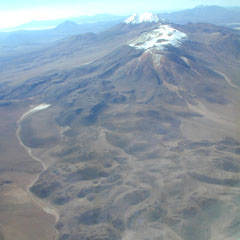Report on Olca-Paruma (Chile-Bolivia) — March 1990
Bulletin of the Global Volcanism Network, vol. 15, no. 3 (March 1990)
Managing Editor: Lindsay McClelland.
Olca-Paruma (Chile-Bolivia) Fumarolic activity and minor seismicity
Please cite this report as:
Global Volcanism Program, 1990. Report on Olca-Paruma (Chile-Bolivia) (McClelland, L., ed.). Bulletin of the Global Volcanism Network, 15:3. Smithsonian Institution. https://doi.org/10.5479/si.GVP.BGVN199003-355050
Olca-Paruma
Chile-Bolivia
20.939°S, 68.413°W; summit elev. 5705 m
All times are local (unless otherwise noted)
Fumarolic activity, accompanied by low-intensity seismicity, was described by policemen from Ujina, 15 km SW of Olca, on 13 November 1989. Minor seismicity associated with Olca was noted in mid-March 1990 by state oil company (ENAP) geologist Patricio Sepulveda.
Geological Summary. A 15-km-long E-W ridge forming the border between Chile and Bolivia is comprised of several stratovolcanoes with Holocene lava flows. Andesitic-dacitic lava flows extend as far as 5 km N from the active crater of Volcán Olca and to the north and west from vents farther to the west. Olca is flanked on the west by Cerro Michincha and on the east by Volcán Paruma, which is immediately west of the higher pre-Holocene Cerro Paruma volcano. Volcán Paruma has been the source of conspicuous fresh lava flows, one of which extends 7 km SE, and has displayed persistent fumarolic activity. The only reported historical activity from the complex was a flank eruption of unspecified character between 1865 and 1867, which SERNAGEOMIN notes is based on unconfirmed records.
Information Contacts: J. Naranjo, SERNAGEOMIN.

